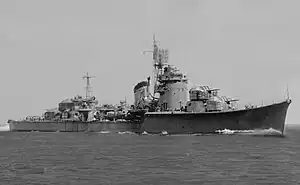 Fuyutsuki on 23 May 1944. | |
| History | |
|---|---|
| Name | Fuyutsuki |
| Ordered | 1942 |
| Builder | Maizuru Naval Arsenal |
| Cost | 17,820,400 JPY (as naval budget)[1] |
| Laid down | 8 May 1943 |
| Launched | 20 January 1944 |
| Completed | 25 May 1944 |
| Commissioned | 25 May 1944 |
| Reclassified |
|
| Stricken | 20 November 1945 |
| Homeport | Yokosuka |
| Fate | Scrapped and converted breakwater in May 1948 |
| General characteristics | |
| Class and type | Akizuki-class destroyer |
| Displacement |
|
| Length | 134.2 m (440 ft 3 in) |
| Beam | 11.6 m (38 ft 1 in) |
| Draft | 4.15 m (13 ft 7 in) |
| Propulsion |
|
| Speed | 33 knots (38 mph; 61 km/h) |
| Range | 8,300 nmi (15,400 km) at 18 kn (21 mph; 33 km/h) |
| Complement | 300 |
| Armament |
|
Fuyutsuki[2][3] (冬月, "Winter Moon") was an Akizuki-class destroyer of the Imperial Japanese Navy. Her name means "Winter Moon".
Construction and career
On 25 May 1944, Fuyutsuki was completed at Maizuru Naval Arsenal, and she was assigned to the 11th Destroyer Squadron, Combined Fleet.[4]
On 24 June, she sailed to Yokosuka with Landing Ship No. 4 and Landing Ship No. 104.[5] On 25 June, she escorted the I-Gō Transport Squadron,[6] on 29 June, she was deployed to Chichi-jima with the cruiser Nagara and destroyer Matsu. They returned to Yokosuka on 3 July.[7]
On 11 July, she sailed to Tokuyama with the destroyer Kiyoshimo. On 14 July, she joined the Ro-Gō Transport Squadron,[8] and sailed to Nakagusuku Bay. On 15 July, she was assigned to the 41st Destroyer Division, 10th Division, 3rd Fleet with the destroyer Shimotsuki.[9] Fuyutsuki returned to Kure on 26 July.[7]
On 12 October, while escorting the light cruiser Ōyodo from Yokosuka to the Inland Sea, she was hit in the bow by a torpedo fired from the submarine USS Trepang. She returned to Kure where she was repaired.
On 31 January 1945 she ran aground on a sandbar near Ōita during a training mission in the Inland Sea.
Fuyutsuki participated on the last mission of the battleship Yamato (6–7 April 1945). She sank the crippled destroyer Kasumi with two torpedoes after taking aboard her crew.[10] She was one of the few surviving ships, even though lightly damaged by 127 mm rockets and bombs. Her own losses were 12 dead and 12 injured.
On 20 August 1945, Fuyutsuki hit a mine at Moji, Kyūshū, suffering heavy damage to her stern. She surrendered unrepaired and without armament.
References
Notes
- ↑ Senshi Sōsho (1969), p. 815.
- ↑ 1 October 1943, Administrative order No. 235, Named one destroyer, two submarines, one coast defence ship, two minesweepers, and one submarine chaser., Minister's Secretariat, Ministry of the Navy.
- ↑ National Archives of Japan, reference code: C12070120400, p. 1.
- ↑ The Maru Special (1978), p. 35.
- ↑ National Archives of Japan, reference code: C08030127400, p. 20.
- ↑ National Archives of Japan, reference code: C08030127400, p. 21.
- 1 2 National Archives of Japan, reference code: C08030127500, p. 5.
- ↑ National Archives of Japan, reference code: C08030127500, p. 32.
- ↑ National Archives of Japan, reference code: C08030127500, p. 31.
- ↑ Spurr, Russell (1981). A Glorious Way To Die - The Kamikaze Mission of the Battleship Yamato. New York: Newmarket Press. pp. 305. ISBN 9781557049131.
Sources
- Sturton, Ian (1980). "Japan". In Chesneau, Roger (ed.). Conway's All the World's Fighting Ships 1922–1946. Greenwich, UK: Conway Maritime Press. ISBN 0-85177-146-7.
- Whitley, M. J. (2000). Destroyers of World War Two: An International Encyclopedia. London: Cassell & Co. ISBN 1-85409-521-8.
- Ushio Shobō (Ushioshobokojinsha Co., Ltd.), Tōkyō, Japan.
- The Maru Special, Imperial Japanese Vessels No. 19, Destroyer Asashio-class and Akizuki-class, 1978.
- Senshi Sōsho, Asagumo Shimbunsha Inc., Tōkyō, Japan.
- Vol. 31, Naval armaments and war preparation (1), "Until November 1941", 1969.
- Japan Center for Asian Historical Records (http://www.jacar.go.jp/english/index.html), National Archives of Japan, Tokyo, Japan.
- Reference code: C12070120400, October (1), Minister's Secretariat, Ministry of the Navy, 1943.
- Reference code: C08030127400, Wartime log book from June 1, 1944 to June 30, 1945, 11th Torpedo Squadron (1), HQ of 11th Destroyer Squadron, Imperial Japanese Navy, 1944.
- Reference code: C08030127500, Wartime log book from June 1, 1944 to June 30, 1945, 11th Torpedo Squadron (2), HQ of 11th Destroyer Squadron, Imperial Japanese Navy, 1944.